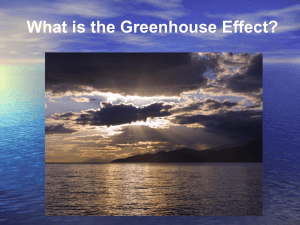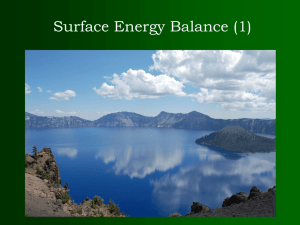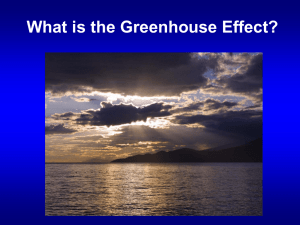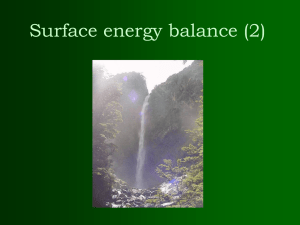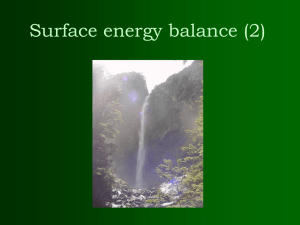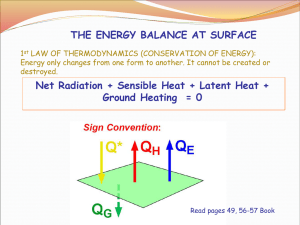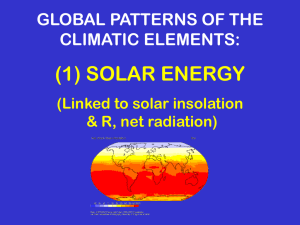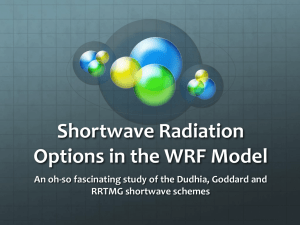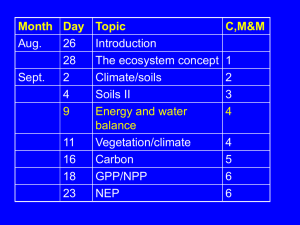Surface energy balance
advertisement
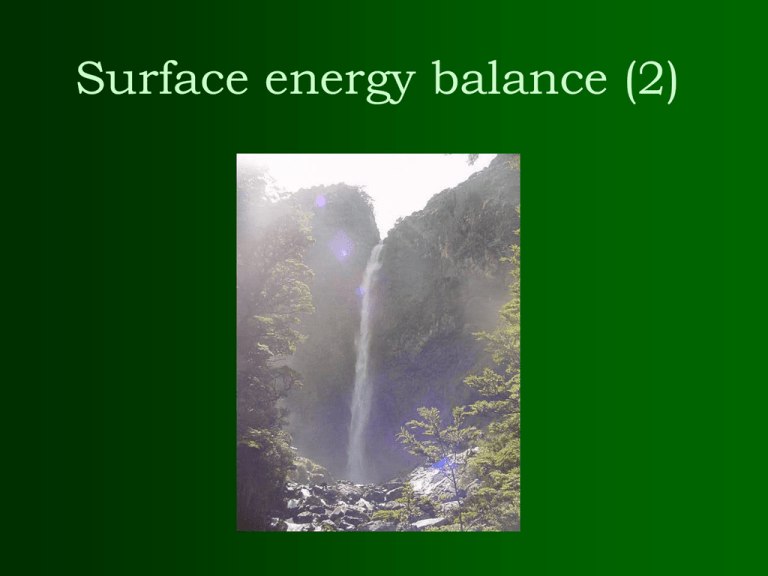
Surface energy balance (2) Review of last lecture – What is energy? 3 methods of energy transfer – The names of the 6 wavelength categories in the electromagnetic radiation spectrum. The wavelength range of Sun (shortwave) and Earth (longwave) radition – Earth’s energy balance at the top of the atmosphere. Incoming shortwave = Reflected Shortwave + Emitted longwave – Earth’s energy balance at the surface. Incoming shortwave + Incoming longwave = Reflected shortwave + Emitted longwave + Latent heat flux + Sensible heat flux + Subsurface conduction Surface energy balance Incoming shortwave + Incoming longwave = Reflected shortwave + Emitted longwave + Latent heat flux + Sensible heat flux + Subsurface conduction SWdn SWup LWdn LWup LH SH dT/dt Fc Incoming solar radiation SWdn = S cos where S is solar constant S=1366 Watts/m2 is solar zenith angle, which is the angle between the local zenith and the line of line of sight to the sun Reflected solar radiation SWup = SWdn where is albedo, which is the ratio of reflected flux density to incident flux density, referenced to some surface. Global map of surface albedo Incoming and surface emitted longwave radiation • Incoming longwave radiation can be estimated from air temperature using the blackbody approximation • Surface emitted longwave radiation can be estimated from surface temperature using the blackbody approximation Physical Representation of Radiation • Blackbodies: purely hypothetical bodies that absorb and emit the maximum radiation at all wavelengths • The Earth and the sun are close to blackbodies. • The atmosphere is not close to blackbody, but it can served as the first order approximation Stefan-Boltzmann Law • States that radiation emitted from a blackbody is a function ONLY of temperature • Hotter bodies emit more energy than colder bodies I=T4 where I is the intensity of the radiation, T is the temperature in K, and is the Stefan-Boltzmann constant, 5.67 x 10-8 W m-2 K-4) • So, double T, 16x more radiation • Earth (290K)= 401 Wm-2, Sun (6000K) = 7.3 x 106 Wm-2. So ISun >> Iearth • Incoming LW (air-emitted): LWdn = Tair4 • Surface emitted LW: LWup=Ts4 Net longwave radiation ( LWdn - Lwup = Tair4 - Ts4 ) • Is generally small because air temperature is often close to surface temperature • Is generally smaller than net shortwave radiation even when air temperature is not close to surface temperature • Important during the night when there is no shortwave radiation Surface “Sensible” and “Latent” heat transfers First, recall 2 other methods of energy transfer in addition to radiation: 1. Conduction – This is how excess heat in ground is transferred to the atmosphere via an extremely thin layer of air in contact with the surface 2. Convection – Once the heat is transferred from the surface to the air via conduction, convection takes over from here via “sensible” and “latent” heat transfers Sensible heat flux • Sensible heat: heat energy which is readily detected • Sensible heat flux SH = Cd Cp V (Tsurface - Tair) Where is the air density, Cd is flux transfer coefficient, Cp is specific heat of air (the amount of energy needed to increase the temperature by 1 degree for 1 kg of air), V is surface wind speed, Tsurface is surface temperature, Tair is air temperature • Magnitude is related surface wind speed – Stronger winds cause larger flux • Sensible heat transfer occurs from warmer to cooler areas (i.e., from ground upward) • Cd needs to be measured from complicated eddy flux instrument Latent Heat • Energy required to induce changes of state in a substance • In atmospheric processes, invariably involves water • When water is present, latent heat of evaporation redirects some energy which would be used for sensible heat – Wet environments are cooler relative to their insolation amounts • Latent heat of evaporation is stored in water vapor – Released as latent heat of condensation when that change of state is induced Latent heat flux • LH = Cd L V (qsurface - qair) Where is the air density, Cd is flux transfer coefficient, L is latent heat of water vapor, V is surface wind speed, qsurface is surface specific humidity, qair is surface air specific humidity • Magnitude is related surface wind speed – Stronger winds cause larger flux • Latent heat transfer occurs from wetter to drier areas (i.e., from ground upward) • Cd needs to be measured from complicated eddy flux instrument Seasonal variation of surface energy budget Storage change = net radiation - latent heat flux sensible heat flux Summary: Surface energy balance Incoming shortwave + Incoming longwave = Reflected shortwave + Emitted longwave + Latent heat flux + Sensible heat flux + Subsurface conduction SWdn =Scos SWup =SWdn LWdn LWup =Tair4 =Ts4 LH=CdLV(qsurface- qair) SH=CdCpV(TsurfaceTair) dT/dt Fc = - dT/dz
